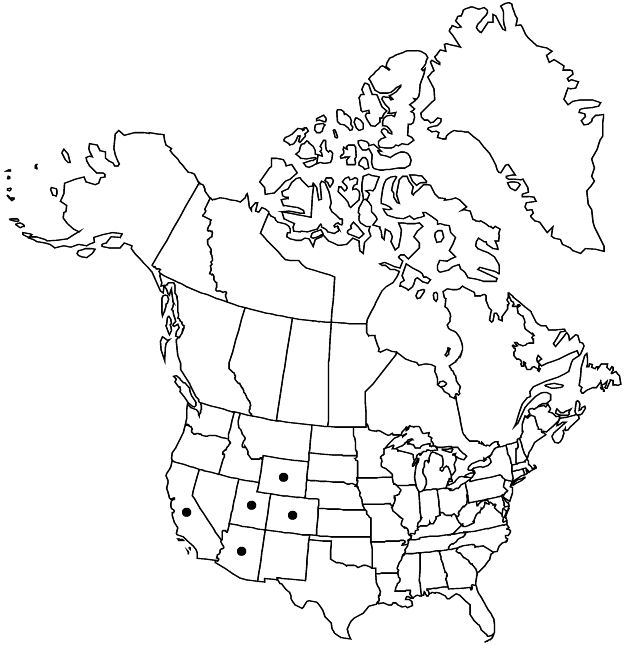Difference between revisions of "Amelanchier alnifolia var. pumila"
Ill. Handb. Laubholzk. 1: 739. 1906.
FNA>Volume Importer |
FNA>Volume Importer |
||
| Line 15: | Line 15: | ||
|name=Amelanchier canadensis var. pumila | |name=Amelanchier canadensis var. pumila | ||
|authority=Torrey & A. Gray | |authority=Torrey & A. Gray | ||
| + | |rank=variety | ||
|publication_title=Fl. N. Amer. | |publication_title=Fl. N. Amer. | ||
|publication_place=1: 474. 1840 | |publication_place=1: 474. 1840 | ||
| Line 33: | Line 34: | ||
|elevation=2000–3400 m | |elevation=2000–3400 m | ||
|distribution=Ariz.;Calif.;Colo.;Utah;Wyo. | |distribution=Ariz.;Calif.;Colo.;Utah;Wyo. | ||
| − | |discussion=<p>The most distinctive features of < | + | |discussion=<p>The most distinctive features of <i></i>var.<i> pumila</i> are that its leaves, pedicels, sepals, and ovary apices are glabrous (with the exception of a few hairs on emerging leaves and a ring of hairs around the base of the styles in some plants), and its leaf teeth are relatively long and sharp-pointed. This variety appears to be restricted to higher elevations.</p> |
|tables= | |tables= | ||
|references= | |references= | ||
| Line 42: | Line 43: | ||
-->{{#Taxon: | -->{{#Taxon: | ||
name=Amelanchier alnifolia var. pumila | name=Amelanchier alnifolia var. pumila | ||
| − | |||
|authority=(Torrey & A. Gray) C. K. Schneider | |authority=(Torrey & A. Gray) C. K. Schneider | ||
|rank=variety | |rank=variety | ||
| Line 57: | Line 57: | ||
|publication year=1906 | |publication year=1906 | ||
|special status=Endemic | |special status=Endemic | ||
| − | |source xml=https://jpend@bitbucket.org/aafc-mbb/fna-data-curation.git/src/ | + | |source xml=https://jpend@bitbucket.org/aafc-mbb/fna-data-curation.git/src/f50eec43f223ca0e34566be0b046453a0960e173/coarse_grained_fna_xml/V9/V9_1120.xml |
|subfamily=Rosaceae subfam. Amygdaloideae | |subfamily=Rosaceae subfam. Amygdaloideae | ||
|tribe=Rosaceae tribe Gillenieae | |tribe=Rosaceae tribe Gillenieae | ||
Revision as of 22:38, 16 December 2019
Shrubs, 1–2(–4) m. Stems 1–50, solitary or in colonies. Leaves: petiole (7–)11.9–19.1(–27) mm; blade orbiculate to oval, (14–)26–37(–50) × (18–)23–36(–43) mm, base usually cordate to truncate, sometimes ± cuneate, apex rounded or subtruncate, surfaces glabrous. Inflorescences (6 or)7–9(–12)-flowered, (24–)29–40(–47) mm. Pedicels proximalmost (8–)10–20(–27) mm. Flowers: sepals (2.7–)3.2–4(–4.5) mm; petals obovate to elliptic, (9–)10.9–11.5(–12.6) × (3–)3.8–5.2(–5.9) mm; ovary apex glabrous (or sparsely hairy with a ring of hairs at base of styles). Pomes 8–9 mm diam. 2n = 4x.
Phenology: Flowering May–Jun; fruiting Jul–Sep.
Habitat: Mountain slopes
Elevation: 2000–3400 m
Distribution

Ariz., Calif., Colo., Utah, Wyo.
Discussion
The most distinctive features of var. pumila are that its leaves, pedicels, sepals, and ovary apices are glabrous (with the exception of a few hairs on emerging leaves and a ring of hairs around the base of the styles in some plants), and its leaf teeth are relatively long and sharp-pointed. This variety appears to be restricted to higher elevations.
Selected References
None.